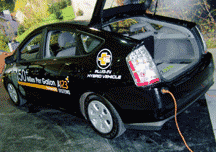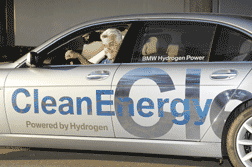|
|||||||||
Steering into the Future
Hyper-charged hybrids and hydrogen-powered SUVs are down the roadby Carrie Madren, Bay Weekly staff writerGaze into the crystal ball: Like a line of ants, modern cars speed along highways that rise and intertwine like a pile of ribbon. Look closer: these future cars aren’t flying — or even all that weird looking. But under their hoods and in their trunks, you’ll find fueling feats of futuristic technology. Last year, Americans bought 1.8 million alternative-fuel vehicles. Marylanders drive 194,000 green cars and trucks. I’m one of them. I first took you green-car shopping in November 2006, when I was deciding between hybrids and flex-fuel vehicles, which can run on either gasoline or another fuel, like ethanol. In March 2007, I made my decision: a 2007 Honda Civic hybrid. Thirteen months later, the new green choices rolling off assembly lines and being designed have me oohing and ahhing. I get about 48 miles to the gallon these days, and I don’t miss stopping at the gas station. But miles-per-gallon envy has me eyeing Smart Cars — which get upward of 60 miles to the gallon — as well as plug-in hybrids that get 150 miles a gallon.
Also on the roads are diesel-fueled luxury cars and hybrids that accept ethanol. Someday, hydrogen-powered vehicles will rule the road as green alternatives to today’s cars. Read on to learn how far we’ve come in adding fuel-efficient and alternative-fuel vehicles to the roads — and how much farther we have to go. On the Fast TrackGreen technology is on the fast track. In many cases, the future is already here. “In 2001, there were 11 alternative-fuel vehicles,” says Charles Territo of the Alliance of Automobile Manufacturers. “This year, we have 70.” The count includes flex-fuel vehicles, hybrids and diesel-fueled vehicles. Since the Toyota Prius first hit the pavement in 1997, we’ve seen many car and truck manufacturers roll out hybrids. Now we have 22 hybrid choices, including Yukons, Porsches, Cadillacs and Lexuses, which all hit the road within the past two years. My Honda Civic hybrid earned me a $2,000 tax credit this year, and many of the newer hybrids offer similar tax incentives ranging from $3,000 for a two-wheel-drive Ford Escape hybrid to $450 for a Lexus LS 600h L hybrid bought last summer. Hybrids will soon come with even more options, among them ethanol-fueled versions and electric plug-ins that run mostly on super-charged batteries. Another present-day option has been right under our noses for decades. You don’t have to hire a psychic to see diesel-fueled BMWs, Jeep Grand Cherokees or Mercedes-Benzes for sale in Maryland. Diesel vehicles have a bad rap for dirty, smoky, loud tailpipes. But diesel-fueled cars generally get more miles to the gallon than their gasoline-powered counterparts, and automobile makers have cleaned up the once-dirty technology and are again marketing diesel cars, as they did in the gas crisis of the 1970s, this time as green alternatives. “Diesel is many times as fuel-efficient as hybrids,” reports Territo. “If you live in a city, where you do a lot of stop-and-go driving, hybrids might be a better choice, but if you drive long distances, diesel might be the better option.”
150 Miles Per GallonYou only have to wait until July to get 150 miles to the gallon. Massachusetts-based A123 Systems will trick out your Synergy-run hybrid system — which comes in the Toyota Prius, among others — with extra power. For about $10,000, the company will install a lithium ion nanophosphate battery into your wheel well and a standard 110-volt plug into your bumper. Before drawing power from the hybrid engine, these retrofitted cars run off the lithium battery — about the size of a briefcase. At the end of the day, simply plug your car in with an extension cord to recharge the battery. Alas, I can’t upgrade my Honda Civic, which has a different battery system. But drivers of more recent Prius models may want to consider this option, although the conversion will void any manufacturer’s warranty. “In essence, you’re turning a good hybrid with a weak battery into a plug-in hybrid,” says A123 Systems’ rep Les Goldman. His company is the only one right now that’s mass-producing these safety-tested, standardized batteries. “This is meant to be for everybody, and we’re hopeful that it will kick-start the plug-in revolution,” Goldman says. That technology will come standard when General Motors finishes developing the Chevy Volt. The factory-installed lithium battery offers a range of 40 miles, with another 400 miles from the small internal combustion engine. Working to bring this plug-in car out of development are more than 200 engineers and 50 designers. Even so, the Volt isn’t likely to hit the road until 2010.
Blast off to the FutureHydrogen-fueled vehicles are the golden egg of green autos — using a renewable resource as well as emitting next-to-clean air. Hydrogen-powered cars were once a Jetson-era dream. Today, engineers from a few companies are developing two main types of hydrogen-fueled engines. One type runs like an electric car, turning hydrogen and oxygen into water. The second is an internal combustion engine — like natural gas-powered engines — modified to burn gaseous hydrogen for energy, emitting 1⁄300th of the carbon of gasoline-fueled cars, and miniscule amounts of hydrocarbon, carbon monoxide and nitric oxide. These days, we’re most likely to see a hydrogen car all polished up in a show room or at an auto show. But General Motors hopes to mass-produce its zero-pollution, non-fossil-fuel-burning, fuel-cell cars by 2010. For the time being, however, all of GM’s concept fuel-cell cars are hand-built. BMW has already put out its internal-combustion-engine-powered Hydrogen Seven. But not just anyone can buy it; this limited-production car is only available to opinion-makers. Washington, D.C., postal workers have been driving routes in pilot hydrogen-powered fuel-cell cars for a few years, but now D.C. residents may get behind the wheel for a test drive in Project Driveway — the first large-scale market test of fuel-cell vehicles with real drivers in the real world. The problem is, the Washington metro region has only one hydrogen fueling station; the next-nearest is in central Pennsylvania. California has the most — 17 hydrogen stations. Nationwide, fewer than 70 hydrogen-fuel stations are in operation. I’m hoping that by the time I drive my Civic hybrid into the ground, I’ll be able to purchase a hydrogen-fueled car — and have a nearby fueling station where I can fill ’er up. |
|||||||||
|
|||||||||
|
|
|||||||||
|
© COPYRIGHT 2008 by New Bay Enterprises, Inc. All rights reserved. |
|||||||||
 Volume 16, Issue 18 - May 1 - May 7, 2008
Volume 16, Issue 18 - May 1 - May 7, 2008


